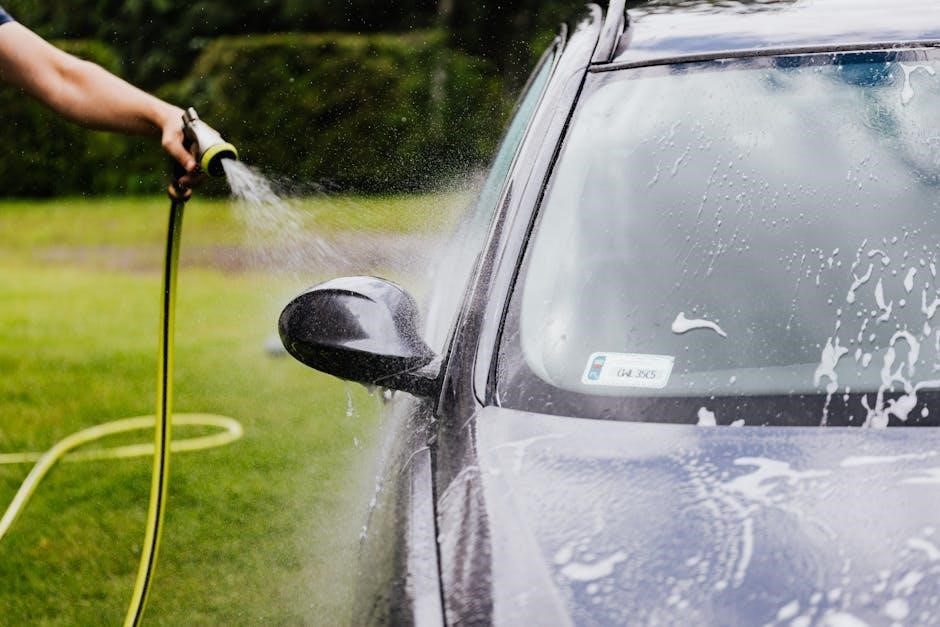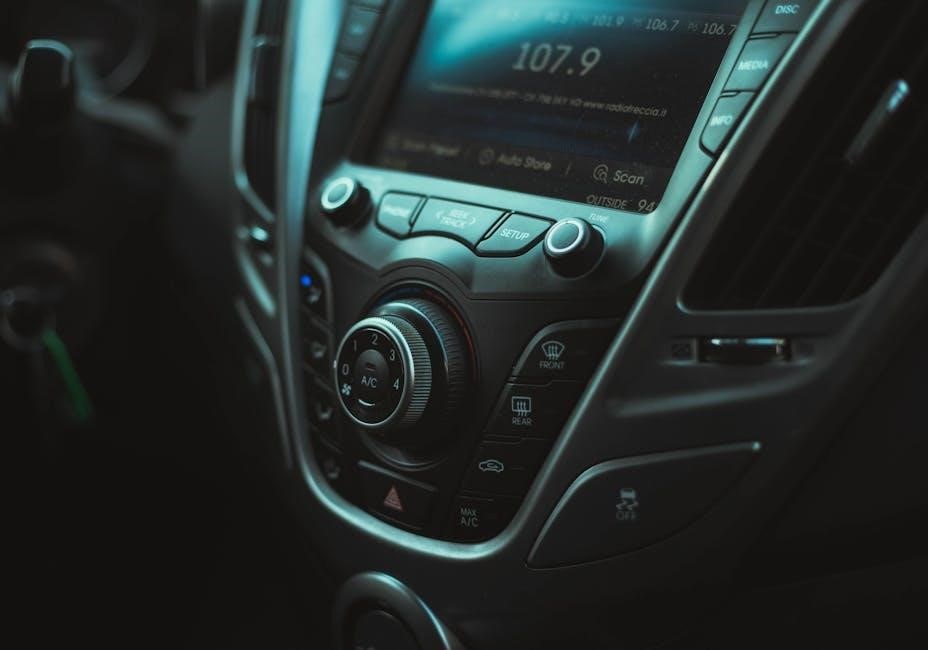Welcome to the Brother MFC-L2710DW manual, your comprehensive guide to setting up, operating, and maintaining this versatile all-in-one laser printer. Designed for small offices, it offers printing, copying, scanning, and faxing capabilities, along with advanced features like wireless connectivity and mobile printing options. This manual provides detailed instructions for troubleshooting common issues, performing routine maintenance, and optimizing printer performance to ensure seamless functionality.
1.1 Overview of the Printer and Its Features
The Brother MFC-L2710DW is a monochrome laser all-in-one printer designed for small offices or home-based workgroups. It offers printing, copying, scanning, and faxing capabilities, with a maximum duty cycle of 15,000 pages per month. The printer supports wireless and wired network connectivity, allowing seamless integration into office environments. It features a print resolution of up to 2400 x 600 dpi and prints at speeds of up to 34 pages per minute. The MFC-L2710DW also includes a 50-sheet automatic document feeder and a 250-sheet paper tray, ensuring efficient document handling. With mobile printing options via Brother’s iPrint&Scan app, this printer is versatile and user-friendly, catering to diverse printing needs.
1.2 Importance of Reading the Manual
Reading the Brother MFC-L2710DW manual is essential for understanding its setup, operation, and maintenance. It provides detailed instructions for troubleshooting common issues, such as error messages or connectivity problems, ensuring optimal performance. The manual also guides users through advanced features like wireless network setup and mobile printing, helping to maximize productivity. By following the manual, users can avoid potential pitfalls, such as incompatible toner cartridges or improper installation, which may lead to hardware issues. Additionally, it offers maintenance tips to extend the printer’s lifespan. Referencing the manual regularly ensures users can fully utilize the printer’s capabilities and resolve problems efficiently, making it a vital resource for both beginners and experienced users.

Installation and Setup Guide
This guide covers unboxing, physical setup, connecting to power, installing drivers, and wireless network configuration for the Brother MFC-L2710DW printer, ensuring a smooth setup experience.
2.1 Unboxing and Physical Setup
Begin by carefully unboxing the Brother MFC-L2710DW printer, ensuring all components, such as the toner cartridge, power cord, and manual, are included. Place the printer on a flat, stable surface, allowing adequate space for proper ventilation. Remove all packaging materials and protective covers from the printer and accessories. Next, install the drum unit and toner cartridge by following the instructions provided in the manual. Load the paper tray with compatible paper, ensuring it is aligned correctly. Finally, connect the power cord to a nearby outlet and press the power button to turn on the printer. Refer to the manual for specific setup instructions to ensure proper installation and functionality.
2.2 Connecting the Printer to a Power Source
To power on your Brother MFC-L2710DW, locate the power cord provided in the box. Plug one end of the cord into the printer’s power port, located on the rear, and the other into a nearby electrical outlet. Ensure the connection is secure to avoid any loose contacts. Avoid using extension cords or power strips, as they may cause instability. Once connected, press the power button on the control panel. The printer will initialize, and the LED lights will illuminate, indicating it is ready for use. For added protection, consider using a surge protector to safeguard against power fluctuations. Always verify that the outlet is functioning properly before connecting the printer.
2.3 Installing Printer Drivers and Software
To ensure optimal performance, install the latest Brother MFC-L2710DW drivers and software from the official Brother support website. Visit the site, enter your printer model, and select your operating system. Download the full driver and software package, which includes the printer driver, scanner driver, and additional utilities like ControlCenter4. For Windows users, run the downloaded installer and follow the on-screen instructions. Mac users can download the Brother iPrint&Scan app from the Mac App Store for wireless printing and scanning. After installation, restart your printer and computer to complete the setup. This ensures all features, including wireless connectivity, function properly.

Basic Operations
The Brother MFC-L2710DW supports essential functions like printing, copying, scanning, and faxing. Use the control panel for quick access to these features, ensuring efficient daily operations.
3.1 Printing Documents
Printing documents with the Brother MFC-L2710DW is straightforward. Ensure paper is loaded in the tray, select the printer in your device settings, and choose desired print options. For wireless printing, connect the printer to your network using the control panel or Brother iPrint&Scan app. The printer supports monochrome printing at high resolution, ideal for text documents. Use genuine Brother toner cartridges for optimal print quality. Adjust settings like paper size and orientation in the printer driver. Troubleshoot common issues like paper jams or poor quality by referring to the manual or Brother support resources. This ensures efficient and reliable printing for home or office use.

3.2 Copying Files
To copy files using the Brother MFC-L2710DW, place the document on the scanner glass or face up in the ADF. Use the control panel to select the copy function and adjust settings like copy quality, brightness, and contrast. The printer supports monochrome copying with high resolution, ensuring sharp text and images. For multiple copies, set the desired quantity and press Start. Troubleshoot issues like blurry copies by cleaning the scanner glass or checking for debris. Refer to the manual for detailed instructions or contact Brother support for assistance. This feature is ideal for quick and efficient document duplication in office or home environments.
3.3 Scanning Documents
To scan documents using the Brother MFC-L2710DW, place the document face down on the scanner glass or in the automatic document feeder (ADF). Use the control panel to select the scan option and choose your preferred settings, such as resolution, file format (e.g., PDF, JPEG, or TIFF), and destination. You can scan directly to a computer, email, or cloud services like Dropbox or Google Drive. For wireless scanning, use the Brother iPrint&Scan app on your mobile device. Adjust brightness and contrast as needed for optimal image quality. Scanned files can be saved to designated folders or sent to predefined locations. Troubleshoot scanning issues by cleaning the scanner glass or checking for debris. Refer to the manual for detailed scanning instructions and troubleshooting tips.
3.4 Sending and Receiving Faxes
To send a fax using the Brother MFC-L2710DW, dial the recipient’s fax number using the keypad and press Start. Place the document face down on the scanner glass or in the ADF. For receiving faxes, ensure the printer is in Fax mode. You can set up automatic fax reception or manually receive faxes by pressing Start when you hear the fax tone. Adjust fax settings, such as resolution and contrast, for clarity. Use the control panel to access advanced fax features like speed dial or delayed sending. Troubleshoot fax issues by checking the phone line connection or ensuring the printer is configured correctly. Refer to the manual for detailed fax setup and troubleshooting guidance.

Advanced Features
The Brother MFC-L2710DW offers advanced features like wireless network setup, mobile printing via Brother iPrint&Scan, and robust security options to protect sensitive data and ensure secure printing.
4.1 Wireless Network Setup

Setting up the Brother MFC-L2710DW on a wireless network enables convenient printing, scanning, and faxing from mobile devices. To begin, access the printer’s menu, select the wireless setup option, and follow on-screen instructions to connect to your Wi-Fi network. Ensure your router is nearby and your network name (SSID) is correctly entered. For added convenience, use the Brother ControlCenter4 utility to configure wireless settings from your computer. The printer supports WEP, WPA, and WPA2 security protocols to safeguard your connection. If issues arise, refer to the manual or Brother’s online support for troubleshooting guides; A stable wireless connection is essential for optimal performance.
4.2 Mobile Printing Options
The Brother MFC-L2710DW supports mobile printing through the Brother iPrint&Scan app, available for iOS and Android devices. This app allows users to print documents, photos, and web pages directly from their smartphones or tablets. Additionally, the printer is compatible with AirPrint and Google Cloud Print, enabling seamless printing from Apple and Android devices without requiring additional setup. For direct device-to-printer connections, Wi-Fi Direct is also supported, eliminating the need for a router. These mobile printing options enhance productivity, offering flexibility and convenience for users who need to print on the go. Ensure your printer and mobile device are connected to the same network for optimal functionality;
4.3 Security Features
The Brother MFC-L2710DW incorporates robust security features to protect your data and ensure secure printing. Secure Print allows you to encrypt print jobs with a PIN, preventing unauthorized access to sensitive documents. Additionally, the printer supports SSL/TLS encryption for secure communication over networks. Administrator settings enable password protection for critical functions, such as fax and network configurations, to prevent unauthorized changes. The printer also includes access controls, allowing you to restrict usage to specific users or groups. These features ensure that your printer remains secure, safeguarding your documents and maintaining the integrity of your office network. Regular firmware updates further enhance security by addressing potential vulnerabilities.
Maintenance and Troubleshooting
Regular maintenance ensures optimal performance. Reset the printer to resolve issues, check error messages for specific problems, and consult the manual or Brother support for troubleshooting guidance.
5.1 Routine Maintenance Tasks
Regular maintenance is crucial for optimal performance. Reset the printer to clear internal memory, addressing issues like “Out of Memory” messages. Clean toner residue using compressed air, ensuring no debris remains. Check and update firmware via Brother’s support website to enhance functionality and fix bugs. Use genuine Brother toner and drum units to maintain quality and prevent chip-related errors; Refer to the manual for specific reset procedures, such as resetting the drum counter when replacing drums. Routine checks for error messages and updating drivers ensure smooth operation. These tasks help prevent hardware issues and extend the printer’s lifespan, keeping it efficient for daily use.
5.2 Replacing Toner and Drum Units

To replace the toner cartridge, turn off the printer, open the front cover, and pull out the drum unit assembly. Remove the toner cartridge from the drum unit, then insert the new toner, ensuring it clicks into place. Reattach the drum unit and close the front cover. For the drum unit, press Menu, select 8 (Machine Info), then 4 (Reset Parts Life) to reset the counter. Always use genuine Brother parts to avoid compatibility issues. Resetting the drum counter is essential when replacing it to ensure proper functionality. Properly dispose of used toner and drum units to maintain environmental standards.
5.3 Common Error Messages and Solutions
The Brother MFC-L2710DW may display error messages like “Out of Memory,” “Manual Feed,” or “Change Toner.” For “Out of Memory,” restart the printer or reduce the print job size. If “Manual Feed” appears, ensure paper is loaded in the manual feed slot. The “Change Toner” message indicates low toner levels; replace the cartridge if necessary. Other errors, such as paper jams, can be resolved by turning off the printer, allowing it to cool, and carefully removing any obstructions. Always refer to the manual or Brother support for specific troubleshooting steps, as some errors may require firmware updates or professional assistance.
Technical Specifications
The Brother MFC-L2710DW is a monochrome laser printer with a monthly duty cycle of 15,000 pages, supporting wireless and mobile printing for enhanced connectivity and efficiency.
6.1 Print Resolution and Speed
The Brother MFC-L2710DW delivers crisp monochrome prints with a resolution of up to 2400 x 600 dpi, ensuring sharp text and detailed graphics. It offers impressive print speeds of up to 34 pages per minute (ppm), making it efficient for high-volume tasks. The first print out time is approximately 8.5 seconds, reducing wait time for urgent documents. With a monthly duty cycle of 15,000 pages, this printer is ideal for small to medium-sized offices. Its robust performance and high-quality output make it a reliable choice for professional environments, balancing speed and precision to meet everyday printing demands effectively.
6.2 Scan and Fax Capabilities
The Brother MFC-L2710DW offers versatile scanning and faxing features, enhancing office productivity. It supports color scanning with a resolution of up to 19200 x 19200 dpi, allowing for detailed and vibrant outputs. Users can scan documents to email, cloud services, or network folders, making it easy to share and store files digitally. The fax function operates at a fast 14.4 Kbps transmission speed, with support for up to 200 speed dials for quick access to frequently used numbers. Additionally, the printer is compatible with Brother’s iPrint&Scan app, enabling mobile scanning and printing. These features make it an efficient all-in-one solution for modern office needs.
6.3 Paper Handling and Compatibility
The Brother MFC-L2710DW is designed to handle a variety of paper types and sizes, ensuring versatility for different printing needs. It features a 250-sheet standard paper capacity, with an optional 250-sheet tray for expanded capacity. The printer supports letter, legal, executive, and folio sizes, as well as envelopes and labels. It also includes a 50-sheet multipurpose tray for specialty papers. The automatic document feeder (ADF) accommodates up to 50 sheets for scanning and copying. The printer supports duplex printing, allowing for automatic two-sided printing. With compatibility for a range of paper weights, including thin, plain, and thick paper, this printer is ideal for diverse office requirements.

Warranty and Support Information
The Brother MFC-L2710DW comes with a limited warranty covering parts and labor. For support, visit Brother’s official website for FAQs, troubleshooting guides, and contact options. Genuine Brother products are recommended for optimal performance and warranty validity.
7.1 Understanding Your Warranty
The Brother MFC-L2710DW is backed by a limited warranty that covers parts and labor for a specified period. This warranty ensures protection against manufacturing defects, providing peace of mind for users. It is essential to review the warranty terms to understand what is covered and for how long. Additionally, using genuine Brother toner cartridges and drum units is recommended, as non-genuine products may void the warranty. For detailed warranty information, refer to the official Brother website or the printed manual provided with your printer. Understanding your warranty helps you make informed decisions and ensures optimal performance and support for your device.
7.2 Contacting Brother Support
For assistance with your Brother MFC-L2710DW, visit the official Brother Support website, where you can find FAQs, troubleshooting guides, and model-specific resources. Use the “Search by Model Name” feature to locate detailed support for your printer. Additionally, Brother offers various contact options, including phone, email, and live chat, to address technical issues or general inquiries. Ensure to have your printer’s serial number ready for efficient support. Brother also provides downloadable tools, such as the ControlCenter4 Update Tool, to resolve common problems. For the best experience, always use genuine Brother parts and refer to the official manual for guidance.

The Brother MFC-L2710DW manual serves as a complete resource for optimizing your printer’s performance. From initial setup to advanced features, this guide ensures you maximize the printer’s capabilities. Troubleshooting tips and maintenance advice help extend its lifespan. Refer to the technical specifications and warranty details for a comprehensive understanding. By following the manual, you can resolve common issues and enjoy reliable printing, copying, scanning, and faxing. For further assistance, Brother Support is readily available. This manual empowers you to make the most of your Brother MFC-L2710DW, ensuring efficiency and productivity in your home or office environment.


























































































